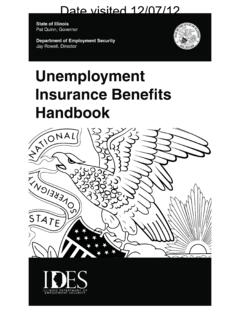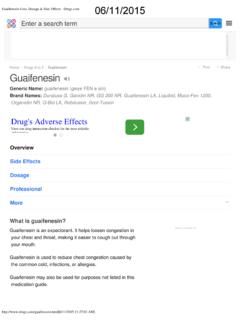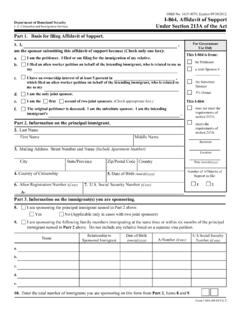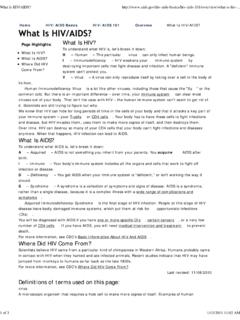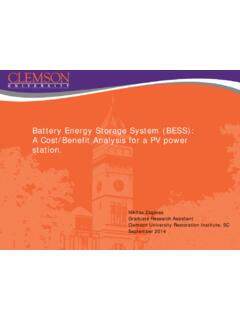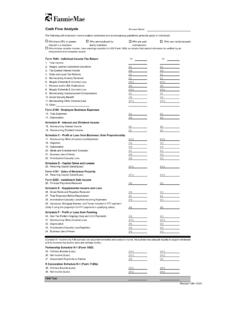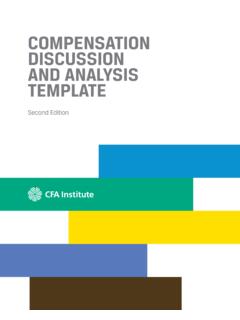Transcription of Cost benefit analysis – some practical examples
1 Visited on 6/26/2014. cost benefit analysis some practical examples John Rolfe Central Queensland University AGSIP 13 Resource Economics visited on 6/26/2014. cost benefit analysis cost - benefit analysis is one of the main ways that economists analyse major development proposals and environmental problems Similar to Net Present Value technique commonly applied in finance Works by identifying all the costs and benefits that would result from a particular resource use These include non-money costs and benefits AGSIP 13 Resource Economics visited on 6/26/2014. Applying cost benefit analysis to NRM Investment Decisions Potential but often difficult to do very well A lot of the benefits are very difficult to quantify A lot of the costs are difficult to quantify Particularly net production changes Not a lot of case studies to follow AGSIP 13 Resource Economics visited on 6/26/2014.
2 Stages in the application process Identify all costs and benefits Measure them Discount them back to common time period Assess whether benefits >costs Assess who bears the benefits and costs Perform sensitivity analysis Assess whether proposal is worth it AGSIP 13 Resource Economics visited on 6/26/2014. CBA of tree clearing Impacts benefits Costs Property level - direct, medium term Income from improved pasture cost of clearing trees, improving production pasture, controlling regrowth - indirect, longer term Possible reduction in grazing Reduced benefit of tree cover (eg pressure on rest of property shade, shelter, nutrient recycling). Improved access for mustering Pastoralists own value for risk of salinity, erosion Pastoralists own value for biodiversity loss External impacts - Social value of land quality Possible reduction in land Possible increased risk of degradation on some properties salinity/erosion above landholder expectations and on other properties - cost of greenhouse gases Impact of land clearing on greenhouse gas emissions - Social value of biodiversity Effect of tree clearing on biodiversity - Indirect effects of production Social value of positive effects on rural communities AGSIP 13 Resource Economics visited on 6/26/2014.
3 Identification of impacts Major problem in the past is that only financial costs and benefits were identified - many environmental and social ones ignored Not always easy to be sure what the outcomes will be of a project Not always agreement about what are important social and environmental impacts to include AGSIP 13 Resource Economics visited on 6/26/2014. Valuing Costs and benefits One of the key stages in cost - benefit analysis was to measure all the costs and benefits Normally do this in terms of dollar values Not always easy, because some items (eg biodiversity protection) are not traded in markets Need special non-market valuation techniques to handle these cases AGSIP 13 Resource Economics visited on 6/26/2014. Non-market valuation techniques Revealed preference techniques Travel cost method used for recreation impacts Hedonic pricing used for housing/lifestyle impacts Averted expenditure techniques Often used to estimate the value of indirect use benefits Storm protection benefits of mangroves AGSIP 13 Resource Economics visited on 6/26/2014.
4 Non-market valuation techniques 2. Stated preference techniques Contingent valuation Choice modelling These are capable of estimating non-use values Key techniques to use in relation to values for biodiversity But often complex, expensive and time consuming to apply AGSIP 13 Resource Economics visited on 6/26/2014. Estimating costs One of the benefits of using competitive tenders is that they provide some estimates of landholder costs Landholders identify the level of incentive required for them to change management AGSIP 13 Resource Economics visited on 6/26/2014. Landholder costs to improve water quality in Mackay Ascending relative bid value (TBS3) for 73 projects $/TBS. 0 10 20 30 40 50 60 70 80. AGSIP 13 Resource Economics Bidders visited on 6/26/2014. benefit transfer Instead of doing a separate valuation study each time, possible to borrow' values from other, previous studies Most studies focused on particular issues, and are not designed to transfer to other situations Values may be sensitive to characteristics Populations involved The way the tradeoffs are framed The scope at which the issue is pitched The scale of the tradeoffs AGSIP 13 Resource Economics visited on 6/26/2014.
5 Three main approaches to benefit Transfer The Prospector' searches for suitable previous studies and transfers results across The Systematic' designs a database of values suitable for benefit transfer The Bayesian' combines both a review of previous studies with potential data gathering AGSIP 13 Resource Economics visited on 6/26/2014. Multi-criteria analysis A bit similar in performance to CBA. Impacts are identified, and then rated by a group of stakeholders and experts Weightings are summed' to give answer Commonly used in the political process because it is Relatively quick and easy Engages stakeholders and experts AGSIP 13 Resource Economics visited on 6/26/2014. some issues with MCA. There are several key issues to consider There is no definitive basis for setting the weightings some potential to be arbitrary Process open to influence by different stakeholders and interest groups Does not allow effective comparison between projects May be difficult to validate after the event (in comparison to CBA).
6 AGSIP 13 Resource Economics visited on 6/26/2014. Valuing recreation benefits of freshwater dams Recreational benefits of dams often unknown not priced in markets Sometimes tradeoffs between use of water for irrigation and reserving it for recreation Assessed value of recreation for 3 dams Surveyed visitors and identified value of their travel time and travel costs to access the dams AGSIP 13 Resource Economics visited on 6/26/2014. Recreational fishing values $5,000,000. $4,500,000. $4,000,000. $3,500,000. $3,000,000. $2,500,000 Occasional anglers $2,000,000 Frequent anglers $1,500,000. $1,000,000. $500,000. $0. Bjelke- Boondooma Fairbairn Petersen AGSIP 13 Resource Economics visited on 6/26/2014. Valuing tradeoffs with water reserves Used choice modelling studies to identify values community had for being cautious with water allocations Surveys conducted in Brisbane and Rockhampton in 2000 - 2002.
7 AGSIP 13 Resource Economics visited on 6/26/2014. Choice Modelling Valuation Technique example choice set Question X: Options A, B and C. Please choose the option you prefer most by ticking ONE box. Fifteen-year effects How much Healthy Kilometres of Protection of Unallocated I would I pay each vegetation left waterways in Aboriginal water choose year in floodplains good health Cultural sites Option A. $0 20% 1500 25% 0%. Option B. $20 30% 1800 35% 5%. Option C. $50 40% 2100 45% 10%. AGSIP 13 Resource Economics visited on 6/26/2014. Coefficient Values for separate reserve levels Coefficient 20%. 15%. 10%. 5%. 0 -5%. -15%. -10%. AGSIP 13 Resource Economics visited on 6/26/2014. Applying the results in the Comet-Nogoa- Mackenzie (CNM) system Brisbane households would pay $ annually to reserve each 1% of water in the CNM system There was 4% currently unallocated Over 20 years and 300,000 households, present value is $78M with discount rate of 8%.
8 Or $59M with 12% discount rate Approximately double if count rest of Qld If 4% were to be allocated = 40,000 ML. At value of $300/ML, total value = $12M. AGSIP 13 Resource Economics visited on 6/26/2014. Applying the results in the Dawson system Brisbane households would pay $ annually to reserve each 1% of water in the Dawson system There was 10% currently unallocated Over 20 years and 300,000 households, present value is $75M if 8% discount rate or $57M if 12% discount rate Approximately double if count rest of Qld If 10% were to be allocated = 201,000 ML. At value of $300/ML, total value = $60M. AGSIP 13 Resource Economics visited on 6/26/2014. Applying the results in the whole Fitzroy system Brisbane households would pay $ annually to reserve each 1% of water in the Fitzroy system There was 15% currently unallocated Over 20 years and 300,000 households, present value is $235M if 8% discount rate or $178M if 12% discount rate Approximately double if count rest of Qld If 15% were to be allocated = 544,800 ML.
9 At value of $300/ML, total value = $163M. AGSIP 13 Resource Economics visited on 6/26/2014. Values for vegetation and waterways over time 5 $ per 1km improvement $ per 1% improvement 4 3. 2. 1 0 0. 2000 2001 2002 2003 2005 2000 2001 2005. Brisbane Rockhampton Vegetation Waterways AGSIP 13 Resource Economics visited on 6/26/2014. Dealing with the risk and uncertainty issues Issues of risk and uncertainty often ignored in stated preference studies Very difficult to communicate these alongside information about attributes and alternatives in choice sets But two key non-use values are related to these issues Option Value Quasi-option value AGSIP 13 Resource Economics visited on 6/26/2014. some evidence of larger option values 100. 90. 80. 70 Brisbane percentage 60 Toow'mba 50. 40 Mackay 30 Rockh'ton 20. 10. 0. Use value Option value Bequest Existence Quasi-option value value value Qld surveys for BT database on soils, waterways, veg.
10 Asked to rated a series of questions representing use and non- use values - From 1 most to 5 (least important). Percentage of respondents scoring values with a 1 or 2 . AGSIP 13 Resource Economics visited on 6/26/2014. Evidence for quasi-option values Donaghy et al (2004) asked households about WTP for a 5 year moratorium on release of GMOs Significant values estimated Median and mean WTP estimates of $220 and $386 per household Respondents did value opportunity to delay introduction of GMO's Positive and significant income variable suggests that as income increases so does quasi-option values Confirms that community has values for being cautious with GMO's AGSIP 13 Resource Economics visited on 6/26/2014. some policy implications Important to assess non-use values for biodiversity impacts in same context as agricultural ones Stated preference techniques can be used for this benefit transfer provides a way of getting rough estimates These tools make it more feasible to do cost - benefit analysis Allows priority setting and investment evaluation to be more rigorous.
